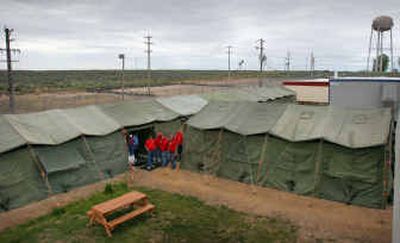Tents relieve crowded prison

BOISE – Idaho’s prison overcrowding comes down to this for inmate Stephen Bartch: He’s living in a tent, and he’s glad.
The long, dark-green, 32-man tent is less crowded, less noisy and a lot more peaceful than the 48-man dorm at the Southern Idaho Correctional Institution that he moved out of three weeks ago, said Bartch, a 50-year-old diesel mechanic from Caldwell.
“I’ve camped out before, and this isn’t camping out as far as I’m concerned,” said Bartch, as he sat on his bunk, belongings stowed in a plastic box underneath, and leaned over to turn off a small TV. “They’ve made it livable.”
Inmates are moving into tents at two of Idaho’s prisons as the state struggles to house a swelling prison population that’s well over capacity. As of Wednesday, Idaho had 6,437 inmates serving time – but its prison capacity is only 6,068. Rented county jail beds, tents, cots and double-bunking are among the ways prisons are handling the overflow.
Prison officials acknowledge that putting inmates in tents is anything but ideal. “Personally, I don’t think it’s a good idea,” said Pam Sonnen, administrator of operations for Idaho’s prison system. “I think it disrupts the institution. It’s not good programmatically, it’s not good for staffing.”
The minimum-security Southern Idaho Correctional Institution has two 32-man tents set up near its back fence, but Sonnen said only two additional guards have been added. Plus, officials worry that the tents block the line of sight to the fence, creating additional risk of escape.
This year, the second year that SICI has added tents, 64 fire crew members have been assigned to live in them. The hope is that those offenders will be off fighting fires much of the time, rather than languishing in the tents.
So far, the tents are working out much better than last year, the first tent experiment at SICI. Last year, 64 regular inmates were double-bunked in a single tent.
“We had a lot more contraband, inmates fighting,” Sonnen said. “It was just constant small disruptions.”
Bartch spent close to two months in the tent last year – at the height of the summer heat in July and August. “It was put up in a hurry,” he said. The tent doors then were zippered and became difficult to open and close. Despite coolers and fans, it was hot. Temperatures often hit 100 degrees on the sagebrush desert south of Boise, and winds howl.
Sonnen said the portable toilets set up for the tent dwellers last year frequently blew over in the wind, creating an unpleasant mess.
“It was a reward, coming back in,” Bartch recalled.
This year, a new modular toilet/shower unit is being installed for the tents; though inmates have been in the tents three weeks and it’s not yet operational. Plywood framed doors lead into Tent Tier A and Tent Tier B. It’s a little humid inside, but the temperature is pleasant.
George Jones, a 50-year-old from Idaho Falls, said, “The amenities this year are a lot better than last year. You can’t expect everything to be up and running right off.”
He added, “I’ve just learned from my previous times being in here, if you keep your mouth shut and do what you’re told, you’re fine. Arguing doesn’t get you nowhere – just gets you in trouble.”
Both Jones and Bartch are looking forward to leaving the prison compound to go fight wildland fires – a job that’s hard work, but a welcome break from the monotony of prison.
Jones is in until 2007, while Bartch has 11 months left to serve, after being convicted of domestic battery. “I’m not proud of it,” he said.
Tents have been used for three years at the state’s prison work camp at St. Anthony. Last fall, a building expansion there wasn’t done on time, and inmates had to stay in the tents until mid-November.
“We don’t want to do that again,” Sonnen said.
“It was getting pretty cold,” said Teresa Jones, state Department of Corrections spokeswoman. “We did receive some family concerns as we went into the fall. It’s not an ideal situation … but it’s the times that we’re in.”
At SICI, the tents, which are heated in cold weather, stayed up through October, and went back up again in mid-April. “It’s real comfortable, as far as I’m concerned,” Bartch said.
SICI Warden Ken Bennett said his institution houses mostly inmates who are nearing release and some who are on work release and leave during the day for jobs or work projects. There’s an emphasis on programming to help those who will soon be released make the transition back into society, but that doesn’t work well with adding tents full of extra inmates.
Walking across the prison grounds toward the long tents, which are tucked between other prison buildings, Bennett said, “As you can see, our resources are a little bit stretched.”
The additional inmates in the tents put more pressure on prison facilities such as the laundry and dining hall.
However, he said, “I think that it’s going very well. The attitudes are good out there in the tents.”